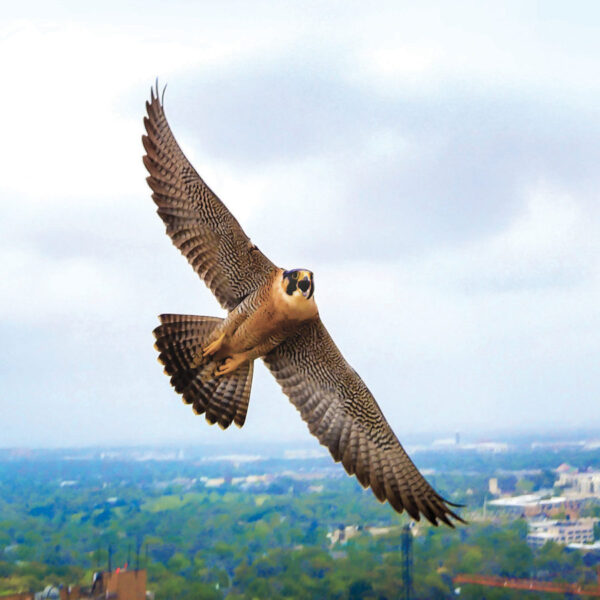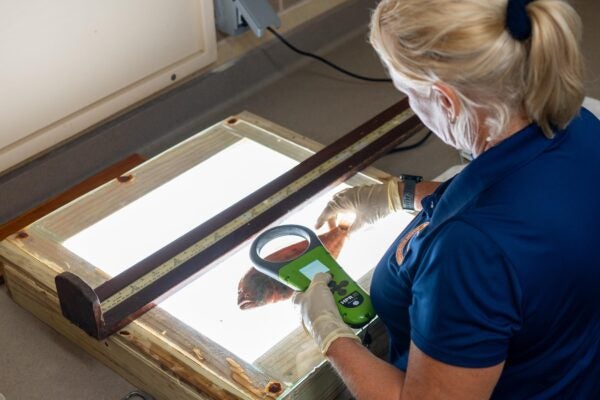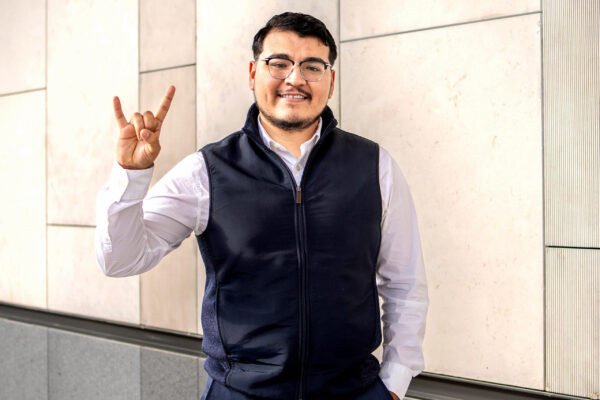Inclusive Instincts
Emily Shryock, assistant director of services for students with disabilities, has been building awareness around accessibility on UT’s campus since she arrived in 2010. She works individually with students and develops campus-wide training for staff and faculty members.
“We always joke that around here there is no typical day,” she says. “I have about 150 students that I work with directly throughout the semester, and then I also coordinate our outreach and training. So, I do a lot of presentations and coordinating trainings across campus.”
Shryock oversees the disABILITY Advocate Training program, which is available for all UT students, staffers and faculty members, and she hopes to broaden the scope of disability education and action around accessibility across the Forty Acres.
The program began in 2011, and several thousand people have completed its courses. The disABILITY Advocate Training program offers a one-hour course, typically popular among students, a 90-minute course aimed at instructors and a two-hour foundation training program for staff members.
“The goal is to create a more accessible, inclusive and welcoming environment for people with disabilities. We are providing not only facts and knowledge about disability, but we’re also giving people very specific skills and concrete tools that they can take with them back to their various roles and create more accessible spaces,” she says.
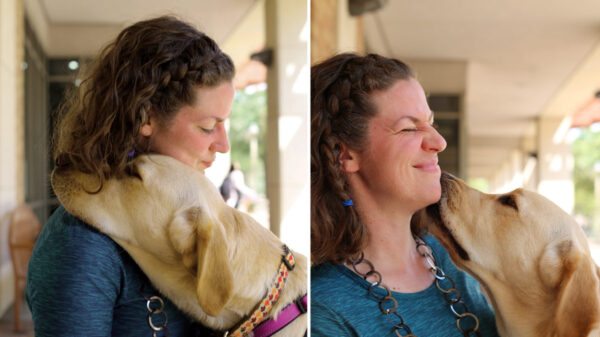
Along with her role of organizing and executing trainings for disability advocacy, Shryock is also tasked with overseeing the administration of service animal programs.
Shryock has extensive experience working with her own service animals and assisting students with their animals. She says that many students, staff members and faculty members with service animals often express frustration with how others interact with their animals on campus. Many people are misinformed about how to interact with service animals, she says.
“Pretty much anywhere you go with a dog, you’re going to have people reacting in — hopefully — a positive way just because they’re excited to see a dog. I think on a college campus where a lot of students are away from their pets, that can just be heightened. And so sometimes people forget that a service dog is working. It has an important job to do.”
Friendly enthusiasm can actually have an adverse effect on the service animals and their partners.
“When people are calling the dog, talking to it, making kissy noises, trying to feed it, all that is distracting the dog. It’s making it very difficult for it to do its job, and it’s potentially putting its human partner in danger if it isn’t paying attention to its work,” she explains.
The best way to interact with a service animal, she says, is usually not to interact with it at all. Shryock knows that can be difficult for dog lovers.
“It’s hard to counteract that human nature of ‘Oh, it’s a dog. I want to go hug it!’ but it’s really important to resist those urges so that the dog can focus on its job and do what it’s been trained to do.”
Tower Girl Power
Neil Crump, the manager of UT’s Project Management and Construction Services, says he never imagined that his job would involve scaling the UT Tower to gather eggs from the university’s resident peregrine falcon, Tower Girl.
On a typical day, Crump balances communication between seven trade shops across campus that work together to provide all construction and maintenance services at the university. The job requires much planning and oversight.
“I try to interact with my supervisors on a daily basis just to make sure that they have everything they need to do their jobs. So, in total there’s about 50 people in my department. I’m in the shops quite a bit, interacting with the crews and whatever they’re working with,” he says.
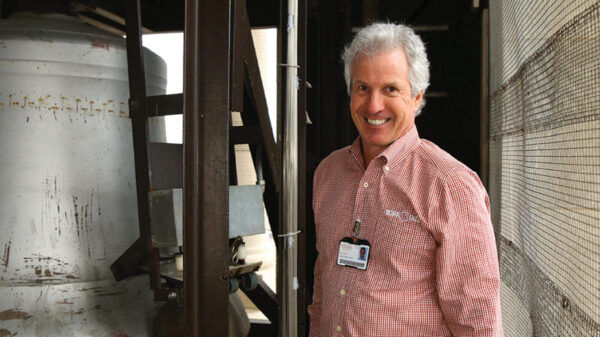
Among his responsibilities, Crump oversees the upkeep of Tower Girl’s home, a comfortable nest box on the top of the UT Tower. Some days, he has to climb the Tower to check on her.
Crump’s falcon duties started after UT alumnus Bruce Calder, an avid falconer, noticed the falcon in the Tower. When he encountered then-President Bill Powers on campus, Calder pitched the idea of building a home for it.
UT eventually approved the request to build the nesting box and enlisted Crump and his team to kick off the operation. Crump jumped into action.
His enthusiasm changed the scope of the project. On one memorable day, he had to climb the Tower to extract eggs so they could be incubated and studied.
While atop the Tower, Crump had the idea to wrap a camera around a long pole so that he could take photos of the inside of the nest box to aid his maintenance and repair duties. From there, the idea evolved into what’s now a 24-hour live feed of Tower Girl’s home. The effort is a collaboration with the university’s Biodiversity Center, which increased the funding for the project and upgraded the equipment. They have also provided the support for research components of the project.
As to caring for the falcon, Crump says that it’s mostly a hands-off effort. Although he frequently checks on the box, its eggs and the bird, he says that Tower Girl is mostly self-sufficient.
“She eats little small birds and insects that are all around, so she’s got a buffet of things to eat,” he says. “So, there’s no caretaking for her.”
In fact, Tower Girl is thriving. She might successfully raise chicks in the fall for the first time in years. According to the Biodiversity Center, Austin is considered the edge of the peregrine breeding range. Tower Girl’s offspring could expand the known breeding range of the species.
All in all, Crump says that his favorite parts of his job here at UT all tie back to the Tower. In addition to looking after Tower Girl, he lights the Tower for gameday wins and commencement ceremonies, oversees the bell chimes and gives Tower tours to visitors and Longhorns alike.
“Well, I guess it all revolves pretty much around the Tower,” he says. “That’s one of the perks of my job. I get to see a lot of stuff. I mean, it’s so fun.”
Keeping Animals Wild (and Safe)
Carin Peterson runs UT’s Animal Make Safe program, and she is the training and outreach coordinator for UT Environmental Health and Safety. She’s the person you call when you have animal emergencies on campus, and she has the stories to prove it.
“The one I always like to tell is the snake in the printer,” she says, recalling one of her most memorable experiences. “There was a department where somebody was working late. They thought they had a paper jam in their printer, and they removed the paper drawer and looked inside and there was a snake,” she says with a laugh. “Who knows how it got there, but they were kind of near the creek. The snake was probably hiding because it was warm, and it was hanging out there.”
Luckily, the department had experienced previous animal incidents and knew to call the hotline. “They took the printer outside, and you know, as soon as I got there, the snake slithered away. But that was pretty crazy.”
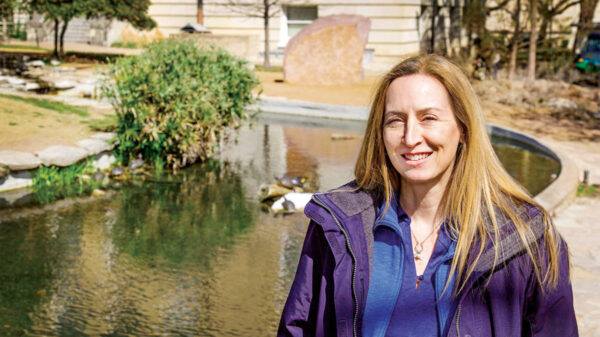
Although not every call is as bizarre as a snake finding solace in the workplace printer, no two days are the same for Peterson and her team, which includes students trained to handle wildlife emergency calls. When she isn’t on call to deal with critters on far corners of campus, she’s organizing trainings and shaping university pet policy. She helps maintain a safe UT campus environment by humanely dealing with wildlife.
Peterson admits that in some ways, she stumbled into her position. She’s a UT alumna with a bachelor’s degree in zoology and a master’s in wildlife biology.
“I was looking for more of a wildlife biologist’s position, and I didn’t know that there would be anything like that under environmental health and safety at the university,” she says. “It was originally a part-time position, but the need was great.”
Although responding to live animal calls at UT keeps her busy all year, the demand is also seasonal.
Animal Make Safe receives fewer calls in the heat of the summer, but they pick up again during the fall. Bat season, which begins in early March, is Peterson’s busiest time.
Currently, she and her team are adapting to new challenges. The rapid construction on campus has caused an increase of the bird, raccoon and opossum presence on campus, and coyote populations have increased at satellite campuses.
One large aspect of the program specifically deals with the bat presence on the main campus. Austin’s bat population is one of the highest in the country, so Peterson and her team often respond to bat calls. Bats can carry disease, so the Animal Make Safe program provides an essential service. In some cases, the Animal Make Safe program works alongside the Austin Bat Refuge in order to rehabilitate and release bats that have been injured on campus.
In the case of a live animal emergency on campus, the Animal Make Safe Hotline is available 24 hours a day. Call 512-471-BATS (2287) for assistance.
